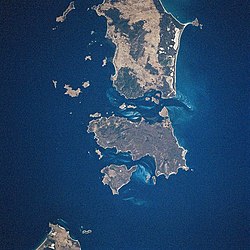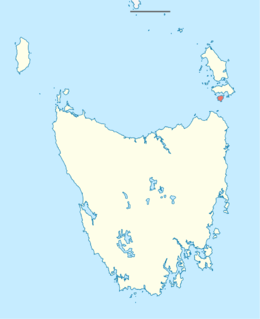Native name: lungtalanana Island | |
|---|---|
 Lying below
Flinders Island and
Cape Barren Island is Clarke Island. The land mass at the bottom left corner is Tasmania. | |
 Clarke Island (Tasmania) | |
| Geography | |
| Location | Bass Strait |
| Coordinates | 40°32′06″S 148°10′12″E / 40.535°S 148.170°E |
| Archipelago | Furneaux Group |
| Area | 82 km2 (32 sq mi) |
| Area rank | 8th in Tasmania |
| Highest elevation | 206 m (676 ft) [1] |
| Administration | |
Australia | |
| State | Tasmania |
| Demographics | |
| Population | 1 (2009) |
The Clarke Island (also known by its Indigenous name of lungtalanana Island [2]), part of the Furneaux Group, is an 82-square-kilometre (32 sq mi) island in Bass Strait, south of Cape Barren Island, about 24 kilometres (15 mi) [3] off the northeast coast of Tasmania, Australia. [4] Banks Strait separates the island from Cape Portland on the mainland. [5] [6]
Off its west coast lies the shipwreck of HMS Litherland, which sank in 1853 and was discovered in 1983. [7] Clarke Island is Tasmania's eighth largest island. [8]
History
Clarke Island/lungtalanana was uninhabited prior to European settlement. Sydney Cove ran aground between Preservation Island and Rum Island on 28 February 1797. [9] A party of seventeen men set off on 28 February 1787 in the ship's longboat to reach help at Port Jackson, 400 nautical miles (740 km) away. This was led by first mate Hugh Thompson, and included William Clark the supercargo, three European seamen and twelve lascars. Ill fortune struck again and they were wrecked on the mainland at the northern end of Ninety Mile Beach. Their only hope was to walk along the shore all the way to Sydney, a distance of over 600 kilometres (370 miles).
They had few provisions and no ammunition, and fatigue and hunger lessened their number as they marched. Along the way they encountered various Aboriginal Tasmanians, some friendly and some not. The last of the party to die on the march was killed by a man Dilba and his people near Hat Hill. Those people had a reputation around Port Jackson for being ferocious. Matthew Flinders and George Bass had feared for their safety when they encountered Dilba the previous year.
In May 1797 the three survivors of the march, William Clark, sailor John Bennet and one lascar had made it to the cove at Wattamolla [10] and, on 15 May 1797, with their strength nearly at an end they were able to signal a boat out fishing, which took them on to Sydney.
On the march Clark had noted coal in the cliffs at what is now called Coalcliff between Sydney and Wollongong. This was the first coal found in Australia. [11] On arrival at Port Jackson, the men informed Governor Hunter of the Sydney Cove and its remaining crew. [12] Hunter despatched the Francis and the Eliza to salvage the ship and take the remaining crew and cargo to Port Jackson. [9]
On the first salvage trip, [12] the crew of the Francis discovered wombats on the island [13] and a live animal was taken back to Port Jackson. [13] Matthew Flinders travelling on board the Francis on its third and final salvage trip also decided to take a wombat specimen from the island to Port Jackson. Governor Hunter later sent the animal's corpse to Joseph Banks at the Literary and Philosophical Society [14] to verify it as a new species. The island was named Clarke island after William Clark. [9] [15]
Sealing is believed to taken place on the island early in the 19th century. [16]
Recent developments

The root fungus pathogen, Phytophthora cinnamomi, known to be able to kill Australian native plants was found in the island in an isolated case, in 2002. [17]
Introduced animals still inhabiting the island include rabbits, cats and rats. [18] In January 2023, a project to remove the feral cats to protect a colony of vulnerable white-fronted terns (Sterna striata) nesting on the island began. [19]
On 10 May 2005, the government released Crown lands on both Cape Barren and Clarke Island to be overseen by the local Aboriginal association. [20] This marked the first official handover of Crown land to an Aboriginal community in Tasmania. As of 2009 [update], Clarke Island had one permanent resident. Current infrastructure is limited and ageing. [21]
Topography
A prominent feature of Clarke Island is a central plateau that rises 110 metres (350 ft). This inland highland provides a limited water catchment from which water flows directly to the sea. [22] The highest elevation point is 206 metres (676 ft), located on a northwestern point of the island. [1] On the eastern shore of the island is a string of white beaches in the Rutherford Cove area.
See also
References
- ^ a b Blake, F. " The Furneaux Group of islands." Mineral Resources Tasmania, Department of Infrastructure, Energy and Resources, State Government of Tasmania. 22 August 1947. Accessed 30 December 2009.
- ^ "Awards and Competitions". Australian Government Department of the Environment, Water, Heritage and the Arts. 25 July 2006. Archived from the original on 8 February 2010. Retrieved 30 December 2009.
- ^ Official Year Book of the Commonwealth of Australia, No. 5 - 1912, Issue 6. Australian Commonwealth - Bureau of Census and Statistics. 1912. p. 78.
- ^ "Clarke Island, Tasmania (Islands & Reefs)". Gazetteer of Australia online. Geoscience Australia, Australian Government. Retrieved 29 December 2009.
- ^ "Bank Strait". Bonzle. Retrieved 20 February 2021.
- ^ "Banks Strait and Franklin Forecast". Bureau of Meteorology. 20 February 2021. Retrieved 20 February 2021.
- ^ Parks & Wildlife Service (25 July 2008). "Litherland". Shipwrecks. Tasmanian Department of Primary Industries, Parks, Water and Environment. Retrieved 26 December 2009.
- ^ "1384.6 - Statistics - Tasmania, 2008". Australian Bureau of Statistics. 3 January 2008. Retrieved 30 December 2009.
- ^ a b c Nash, M. " Maritime Archaeology Monograph and Reports Series No.2 - Investigation of a Survivors Camp from the Sydney Cove Shipwreck Archived 3 March 2016 at the Wayback Machine." Master of Maritime Archaeology Thesis. Department of Archaeology, Flinders University, South Australia. 2004. Accessed 30 December 2009.
- ^ "First Europeon[sic] Steps - Ship Wrecked Sailors". A bit of history. Bega Valley Shire Council. Archived from the original on 18 May 2006. Retrieved 30 December 2009.
- ^ Furneaux Historical Research Association Inc. "The Sydney Cove (vessel): Diaries and Reports". Archived from the original on 28 March 2011. Retrieved 30 December 2009.
- ^ a b Parks & Wildlife Service (21 July 2008). "Voyage, Shipwreck and Salvage". The Sydney Cove. Tasmanian Department of Primary Industries, Parks, Water and Environment. Retrieved 30 December 2009.
- ^ a b Wells, R.T. (1989). "Volume 1B Mammalia". In Walton, D.W. (ed.). Vombatidae. Richardson, B.J. AGPS Canberra/Department of the Environment, Water, Heritage and the Arts - Commonwealth of Australia. p. 4. ISBN 0-644-06056-5. Archived from the original (PDF) on 16 October 2013. Retrieved 30 December 2009.
- ^ Simpson, J. (16 January 2009). "The 'wombat' trail - David Nash". Transient Languages & Cultures. The University of Sydney. Archived from the original on 6 January 2010. Retrieved 30 December 2009.
- ^ Moore-Robinson, J. (1911). A Record of Tasmanian nomenclature, with dates and origins (PDF). The Mercury Printing Office - Hobart, Tasmania. p. 28. Retrieved 30 December 2009.
- ^ Kostoglou, Parry (1996). Sealing in Tasmania historical research project (First ed.). Hobart: Parks and Wildlife Service. pp. 97–98.
- ^ Schahinger, R., Rudman, T. and Wardlaw, T. " Conservation of Tasmanian Plant Species & Communities Threatened by Phytophthora cinnamomi - Strategic Regional Plan for Tasmania - Nature Conservation Branch Technical Report 03/03." Department of Primary Industries, Water and Environment and Resources. March 2003. Accessed 30 December 2009.
- ^ "State of the Environment Report 2009". Tasmanian Planning Commission. 18 December 2009. Archived from the original on 14 March 2011. Retrieved 30 December 2009.
- ^ Cutting, Lucie; Hook, Mim (16 January 2023). "Drones, traps and motion-sensitive cameras enlisted to rid island in Bass Strait of feral cats". ABC News. Australian Broadcasting Corporation.
- ^ "ABORIGINAL AFFAIRS - POLICY ADVICE AND COMMUNITY SERVICES". 2005. Archived from the original on 1 September 2007. Retrieved 10 October 2007.
- ^ Wells, R.; Porter, D. (2009). "Session Five: Clarke Island Case Study – Hybrid SPS Installation" (PDF). Regional Electrical Engineering Forum 2009. IDC Technologies. Archived from the original (PDF) on 31 January 2010. Retrieved 30 December 2009.
- ^ Blake, F. " Preliminary Report on the Furneaux Group of Islands." Mineral Resources Tasmania, Department of Infrastructure, Energy and Resources, State Government of Tasmania. 17 October 1935. Accessed 30 December 2009.